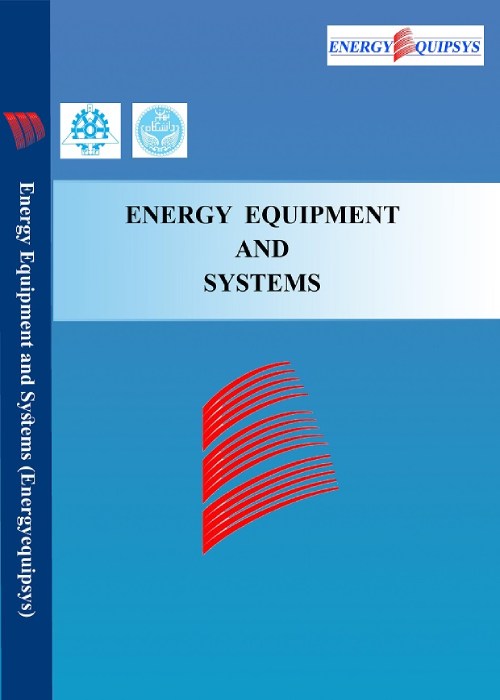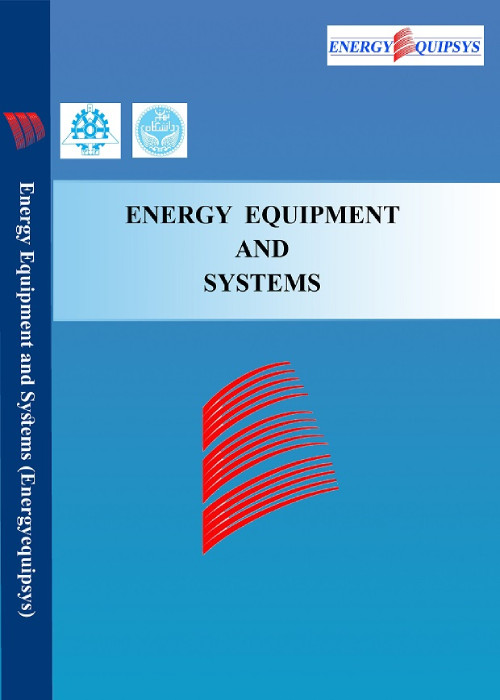فهرست مطالب

Energy Equipment and Systems
Volume:11 Issue: 2, Spring 2023
- تاریخ انتشار: 1402/05/17
- تعداد عناوین: 7
-
-
Transient simulation and 4E Analyses of a hybrid renewable energy system for an educational buildingPages 123-144In this research, an integrated fossil-solar energy system has been designed, modeled, and optimized to supply the required loads of a six-story educational building in Tehran. The three heating, cooling, and electrical loads of the building are extracted in an hourly dynamic pattern for one year. System modeling was performed using a developed code in MATLAB software, and the genetic algorithm was used for two and three objective optimizations. The results show that with the two objectives of exergy efficiency and pollution, 68 rows of PVT panels and a solar collector with an area of 6.25m2 should be used. In this case, the maximum use of solar energy to supply 1945.9MWh heat and 484.5MWh electricity occurred during a year. Also, the highest amount of purchased electricity from the grid is 501.9MWh when the exergy efficiency and cost rate are considered as objective functions. In the three-objective optimization, the best system has an exergy efficiency of 50.21%. The CO2 emission and total cost rate are 7.1$/h and 301g/kWh, respectively. In this case, about 583.06 kWh of the heating load is supplied annually by 20 rows of PVT and a solar collector which has an area of 5.27m2. Photovoltaic panels generate 144.1MWh of the system's required electricity. The electricity sold to the grid in this scenario is 55.05MWh. Also, the system has purchased 204.2MWh of electricity from the grid annually. This means that the system should buy electricity from the grid most of the time each year.Keywords: (4E) Analysis, Optimization, Building, Renewable Energy, Dynamic simulation
-
Pages 145-163Due to the increase in pollution caused by fossil fuels in internal combustion engines, the demand for renewable fuels such as bio-alcohols has increased, so in this study, the focus is on increasing the percentage of pentanol with a combination of other alcohols used in this experiment. Because so far, little study has been done on pentanol. This study was carried out on a water-cooled four-cylinder gasoline engine with different percentages of pentanol, propanol, butanol, and ethanol alcohol combined with gasoline. Fuel compounds in different volume percentages were added to gasoline at 1000, 1500, and 2000 rpm, and the number of pollutants and engine performance were evaluated at each speed. Due to the presence of excess oxygen in the structure of Pentanol, the engine power increases by 61.5 KW. Engine torque increases due to the high latent heat of Butanol and propanol, in the fuel. BSFC improved by 294 N.M compared to pure gasoline due to the high calorific value of alcohols. The pressure of the gases inside the cylinder during combustion and high temperature leads to the production of NOX in the combustion chamber. The lower the amount of Butanol and Propanol in the fuel, the less HC is produced, which can be due to improved combustion quality. The highest amount of HC in the fuel blend No. 2 at 1500 rpm is 2476 ppm. Increasing the combustion temperature due to the presence of alcohols can cause changes in CO. The CO emission also depended on the amount of Propanol and Butanol, which produce more CO in combinations with 10% Butanol and Propanol. The highest average CO2 change compared to pure gasoline is related to the fuel blend No. 1 by 17.37%.Keywords: Renewable Energy, Environmental Pollutants, Gasoline engine, engine performance, Bio-Alcohols
-
Pages 165-191In this comparative study, the thermodynamic and economic investigation of an integrated system driven by a parabolic trough collector and geothermal water is carried out. The proposed multigeneration system is composed of a high-temperature modified Kalina cycle, an electrolyzer, a combined organic Rankine cycle-ejector refrigeration (ORC-EJR) cycle, a reverse osmosis (RO) desalination unit, and a domestic water heater. The absorption fluids applied in the solar collector are AL2O3 and CuO-based nanofluids, and Therminol VP1 as the base fluid. A comprehensive thermodynamic and exergo-economic analysis is carried out for the proposed cycle. Engineering Equation Solver (EES) software is used in all conducted simulations. Nanoparticle percentage, solar irradiation, ambient temperature, and collector inlet temperature were the parameters studied to find their effects on the hydrogen production rate, total net power, useful energy achieved, energy and exergy efficiency, collector outlet temperature, and freshwater production rate. The highest outlet temperature of the solar collector was found to be 688.7 K, and the maximum energetic and exergetic efficiencies of the cycle were 34.45% and 17.25%, respectively. The exergo-economic outputs show that the PEM with 1.99 $/h has the maximum exergy destruction cost rate. The results depicted that CuO-based nanofluid has better performance from the exergy and exergo-economic viewpoints compared to AL2O3-nanofluid. Also, the results proved that the nanoparticle percentage and solar irradiation increases lead to the increase in hydrogen production rate and total net power produced by the system. Moreover, the freshwater production rate increases when the ambient temperature and the collector inlet temperature rise.Keywords: thermodynamic analysis, PTC, Geothermal, multigeneration system, Nanofluids
-
Pages 193-211In this experimental work, the effects of cutting fluid and different cutting parameters on surface roughness, tool wear, and chip morphology during turning of Al7075-T6 were investigated. Machining experiments have been done in different environments such as dry, wet, minimum quantity lubrication (MQL) as well as a homemade ultrasonic nozzle- minimum quantity lubrication (UN-MQL). Ultrasonic vibrations can be used to effectively atomize the cutting fluid into fine and uniform-sized droplets and smaller spray angles with a larger spray deposition distance. The MQL system and machining parameters were evaluated by the design of experiments (DOE) method which allows us to carry out the optimization analysis by performing a relatively small number of experiments while determining the influence on the machining performance using the analysis of variance technique. In the second step, an optimization of the machining parameters was sought using signal-to-noise ratio analysis. Therefore, the response surface methodology was determined in a regression analysis, which was used to model the influence of the parameters on the performance. The fine droplets produced by the UN-MQL system penetrate effectively into the machining zone. Finally, the chip morphology, tool wear and surfaces of the machined parts were examined using optical microscopy to identify the chip formation mechanism in different machining conditions. Cutting tool wear were also examined using the SEM tests to quantify the tool wear zones under specific process parameters. Experimental results show that applying UN-MQL system reduces the surface roughness and tool wear by up to 30% in comparison to the conventional MQL system.Keywords: Minimum Quantity Lubrication, Machining, Ultrasonic Nozzle, Chip Formation, Surface roughness
-
Pages 213-229As it is clear, today's important subject is energy and ways to decrease its consumption. This subject gets more critical in countries with difficulty providing energy for their building consumption, which is responsible for about 30% of annual energy consumption in the whole country. Iran, because of its geographical location, confronts these problems. Passive technologies are essential in NZEB buildings to reduce annual energy consumption. In this research effects of using three significant passive technologies: Roof Vegetation, smart blinders, and Thermochromic windows, are studied separately in EnergyPlus software. The result of this research is that using smart blinders and Thermochromic windows at their optimum condition can reduce the annual energy consumption of a building in the climatic circumstances of Tehran by about 56.51% and 37.94%, respectively.Keywords: cooling load, heating load, thermochromic glasses, smart blinders, roof vegetation
-
Pages 231-246In this study, a numerical simulation of the full-scale train with four carriages is considered, and different fire scenarios on the subway tunnel floor are performed in terms of fire locations and heat release rate variations. The subway tunnel is longitudinally ventilated, where vertical temperature stratification and carbon monoxide (CO) are determined at the mid-line of carriages by a fire-dynamic simulator (FDS). Also, fire hazardous conditions are reported by under-ceiling sensors inside the carriages. The results show that both first and second carriages experience high temperature and CO concentration of smoke flow when the nearest fire location to the carriages is assumed with a fixed fire heat release rate of 10MW (HRR). By changing the fire location in the tunnel, the unsafe situation of the first carriage is reported for two different fire source locations.Keywords: Heat Release Rate of Fire, Fire Location, Train Carriages, temperature distribution
-
Pages 247-259In this study, alternating hexagonal tube as a new form is introduced. The research method is experimental. Experiments were performed on 3 AH tubes in 600 to 1500 Re range. The base fluid was heat transfer oil and ZnO/oil nanofluids with volumetric concentrations of 1% and 2%. Experiments indicate reducing in segments' length lead to increasing heat transfer in AH tubes by a factor of 1.5, 1.8, and 1.9 compared to circular tubes. also Pressure drop increases by 1.07, 1.1 and 1.12 times. The use of nanoparticles and also increasing the concentration of them enhances heat transfer and pressure drop. The least segment's length with 2% particle concentration results in 1.25 and 2.21 times increase in pressure drop and heat transfer compared to the circular tube respectively. Performance Enhanced Ratio is used to investigate pressure drop and heat transfer simultaneously. Our results indicate that the efficiency of the alternating hexagonal tube is higher than the circular tube and enhaces with the increase in number of segments and nanoparticles concentration. The efficiency ratio of alternating hexagonal tubes to circular tube is 1.17, 1.3 and 1.5, respectively. The highest efficiency ratio of nanofluid is 1.77 times the base fluid in a circular tube. The result of this study is that the use of alternating hexagonal tube and nanoparticles improves performance.Keywords: Alternating Hexagonal Tube, Heat Transfer, nanofluid, Pressure drop, Efficiency


